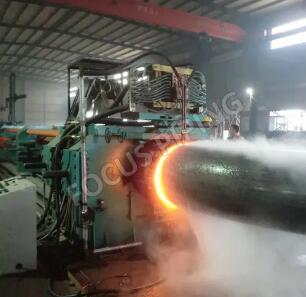Heat Induction Bend (HIB) is an important part of offshore oil and gas exploration, it plays a vital role in offshore oil and gas exploration.
One of the key benefits of using a HIB in offshore oil and gas exploration is that it provides a smooth, gradual bend that helps maintain consistent flow rates and reduces pressure drop. When a pipe bends, the flow of fluid in the pipe is affected. The HIB provides smooth, gradual bends for consistent flow rates and reduced pressure drop. This increases piping efficiency, resulting in significant cost savings in energy consumption and pump maintenance.

Another advantage of using a HIB in offshore oil and gas exploration is that it eliminates the need for multiple welds that would otherwise be required if straight pipe had to be welded to form the bend. This significantly reduces the risk of leaks and failures, resulting in a safer and more reliable piping system. Soldering is a time-consuming process that requires a high degree of skill and accuracy. The more welds required, the greater the risk of human error, which can lead to leaks and other problems. By using HIBs, pipe manufacturers can significantly reduce the number of welds required, thereby reducing the risk of leaks and failures.
Thermal induction elbows can be customized to meet diverse needs, including different diameters and angles. This provides greater flexibility and the ability to more precisely adapt to pipelines on challenging routes. Offshore oil and gas exploration projects often require pipelines to traverse complex terrain, such as deep sea canyons or rocky seabeds. HIBs can be customized to fit any plumbing project, whatever the angle and diameter required. This makes them ideal for offshore oil and gas exploration projects that require high precision.
Another advantage of using HIBs in offshore oil and gas exploration is their robustness. The HIB is made of high-quality steel to withstand high pressure, pressure and harsh environmental conditions. They also have excellent fatigue resistance, reducing the risk of failure due to repeated handling. In offshore oil and gas exploration, pipelines are exposed to a variety of pressures and environmental conditions. HIB is highly durable and strong which makes it ideal for offshore pipeline construction.
HIB is also faster to produce than other bending technologies, reducing lead times and ensuring projects are completed on time. Offshore oil and gas exploration projects can be time sensitive and must adhere to strict deadlines. HIBs can be produced much faster than traditional tube bending techniques, which helps reduce lead times and ensures projects are completed on time. This is especially important in the offshore oil and gas industry, where delays can be costly.
There are also cost savings using HIB. HIBs can be produced in high volumes and require less material, reducing production costs. Additionally, eliminating welding reduces labor costs and possible future repairs. Using a HIB also saves energy, resulting in significant cost savings over the life of the pipeline.
In conclusion, the use of thermal induction bends in offshore oil and gas exploration offers the industry a safer, more efficient and cost-effective solution. Key benefits of using HIBs include improved flow efficiency, elimination of multiple welds, customizability, durability, faster production times, and cost savings. These advantages make the HIB ideal for pipeline manufacturers looking for a reliable, efficient way to build pipelines that can withstand the harsh conditions of offshore oil and gas exploration.
Previous: Creating Unique Custom Marble Statues: A Journey of Artistic Expression
Next: Security Fencing
Copyright:@2020-2021
Comments Please sign in or sign up to post.
0
0 of 500 characters used